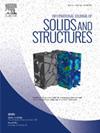循环弯曲作用下胶粘剂内衬管起皱行为
IF 3.4
3区 工程技术
Q1 MECHANICS
International Journal of Solids and Structures
Pub Date : 2025-06-18
DOI:10.1016/j.ijsolstr.2025.113531
引用次数: 0
摘要
内衬管是一种典型的复合材料结构,其起皱行为威胁着内衬管的使用寿命和结构完整性。一种新型的内衬管道,具有良好的抗皱性能。然而,胶粘剂内衬管起皱的机理尚不清楚。本文对新型胶粘剂内衬管的起皱行为进行了数值研究。首先,采用有限元方法对粘接衬管结构在循环弯曲荷载作用下的起皱行为进行了研究。其次,研究了粘接层缺陷长度的影响。最后,验证了局部焊接和无胶区(GFZ)对粘接衬管结构稳定性的影响。结果表明,粘结层内的缺陷是起皱形成的重要因素,在缺陷区域会形成起皱。缺陷尺寸越大,起皱行为越严重,对粘结层的破坏越大。结果还表明,在循环弯曲荷载作用下,这些区域的起皱行为最小,不会对粘接层造成损伤,因此GFZ和粘接层的局部焊接设计更为合理。本文章由计算机程序翻译,如有差异,请以英文原文为准。
Wrinkle behavior of adhesive lined pipe under cyclic bending
The wrinkle behavior threatens the life and structural integrity of lined pipe, which is a typical composite structure. A new lined pipe with an adhesive layer exhibits excellent resistance to wrinkling. However, the mechanism of wrinkling in adhesive lined pipe remains unclear. In this paper, the wrinkle behavior of the new adhesive lined pipe is studied numerically. Firstly, the wrinkle behavior of adhesive lined pipe structure under cyclic bending load is examined by the finite element method. Secondly, the effect of the length of defects in the adhesive layer is studied. Finally, the influence of local welding and Glue-Free-Zone (GFZ) on the structural stability of the adhesive lined pipe is verified. The results imply that defects within the adhesive layer are a significant factor in wrinkling formation, with wrinkles forming in defect areas. The larger the defect size, the more severe the wrinkle behavior becomes, leading to greater damage to the bonding layer. Results also suggest that the design of GFZ and local welding in adhesive lined pipe structures is more reasonable, as wrinkle behavior in these areas under cyclic bending loads is minimal and does not cause damage to the bonding layer.
求助全文
通过发布文献求助,成功后即可免费获取论文全文。
去求助
来源期刊
CiteScore
6.70
自引率
8.30%
发文量
405
审稿时长
70 days
期刊介绍:
The International Journal of Solids and Structures has as its objective the publication and dissemination of original research in Mechanics of Solids and Structures as a field of Applied Science and Engineering. It fosters thus the exchange of ideas among workers in different parts of the world and also among workers who emphasize different aspects of the foundations and applications of the field.
Standing as it does at the cross-roads of Materials Science, Life Sciences, Mathematics, Physics and Engineering Design, the Mechanics of Solids and Structures is experiencing considerable growth as a result of recent technological advances. The Journal, by providing an international medium of communication, is encouraging this growth and is encompassing all aspects of the field from the more classical problems of structural analysis to mechanics of solids continually interacting with other media and including fracture, flow, wave propagation, heat transfer, thermal effects in solids, optimum design methods, model analysis, structural topology and numerical techniques. Interest extends to both inorganic and organic solids and structures.

 求助内容:
求助内容: 应助结果提醒方式:
应助结果提醒方式:


